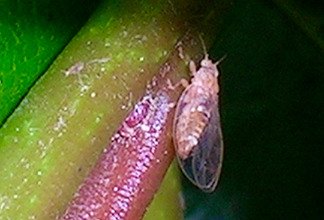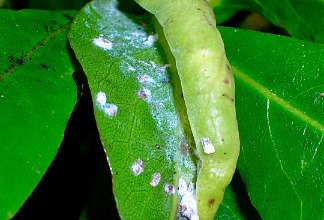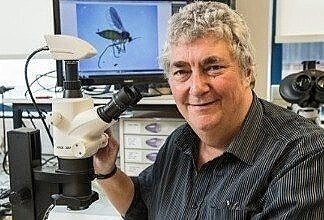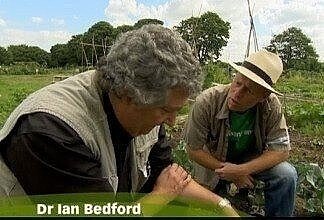
Have you spotted this pest on your bay trees?
5 Minute Read
Dr Ian Bedford tells us everything we need to know about the 'bug of the month' for June, the bay sucker psyllid.From homemade meaty stews to vegetarian hot pots there’ll be one ingredient that’s quite essential for creating those unique, mouth watering flavours; an aromatic leaf from a bay tree.
Bay is thought to be the oldest cultivated tree and, originating from the Mediterranean region, it’s grown on every continent, where its evergreen leaves have become a key ingredient of traditional recipes throughout the world.
Here in Britain, the bay leaf is one of our most used herbs, with many gardens having a tree in a border or a pot. As with all aromatic herbs, their distinctive fragrant oils are produced for the plant’s defence, with glandular structures to repel or deter herbivores that attempt to feed on their leaves.
However, a few species of invertebrates have adapted to feed on plants that produce aromatic oils, and these have a specific monophagous association with that one plant type. This is advantageous to the invertebrate, enabling it to infest its host plant with little or no competition from other herbivores.
This is the case with an insect called the Bay Sucker psyllid, Trioza alacris, a sap-sucking hemipteran insect, that is only found existing on bay trees.


What are Bay Sucker psyllids?
Adult bay sucker psyllids (or Jumping Plant Lice as they’re sometimes called), are 2mm in length and resemble greenish-brown, winged aphids.
During spring, they emerge from amongst the leaf litter below a bay tree where they have remained dormant throughout winter. Ascending the tree to the tender new growth areas, the psyllids push their stylets into the edges of young leaves and begin feeding on the sap. Whilst doing so, a chemical in their saliva causes the leaf edges to curl and blister, which creates a protected environment on the leaf for the psyllids to mate and lay their eggs within.
Eggs that hatch into little nymphs continue to feed on the leaf sap and cause further deformity and yellowing of the leaves, secreting a fluffy white wax from their bodies that repel rainwater from the infested areas. Throughout the summer months, up to three generations of bay sucker psyllids can occur on an infested bay tree, before the adults descend to the ground to hibernate over winter amongst leaf litter and detritus.
How to control Bay Sucker psyllids
Although the leaf damage caused by bay sucker psyllids can be unsightly, it rarely harms the tree and even on heavily infested trees, many leaves can remain unaffected throughout the year.
However, infestations can be managed if the trees are not too large, simply by picking off or pruning out as many of the affected deformed leaves as possible and disposing of them away from the tree. Thorough spraying of the whole tree at regular intervals with the non-toxic, soap-based product SB Plant Invigoratorwill then help prevent re-infestations. Finally, during autumn, rake out and remove leaf litter from under the tree where any adult Psyllids could be preparing to hibernate.

About Dr Ian Bedford
Ian has been fascinated by the bug world for as long as he can remember. From studying butterflies on the South Downs as a youngster, he went on to pursue a career in Research Entomology and ran the Entomology Dept at the John Innes Centre in Norwich up until his recent retirement.VISIT WEBSITE

'Bug of the month'
Visit our 'bug of the month' archive.
Every month Ian will share his knowledge on how to protect your plants and gardens from preventable pest invasions while providing valuable insights into the insects regularly found in our gardens.
find out more
Comments (0)
Why not be the first to send us your thoughts?
Leave A Comment
Most popular articles
1
Plastic plant pots dimensions and uses2
Peat vs Peat Free - Choosing the right Potting Compost3
How to Grow Watercress at home in plant pots4
January Jobs5
Our guide to seed sowing compost